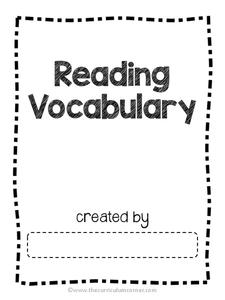Nosapo
Getting to Know Each Other
How do you do? Guide learners through the basics of conversational English with an extensive set of discussion questions. Class members ask partners more about themselves, including their favorite hobbies, music, and time of day, as well...
Curated OER
Finish the Sentences
Young English language learners complete 20 sentence frames provided with this worksheet. Some are questions, and some are declarative sentences. Good practice for your language learners!
Curriculum Corner
Academic Reading Vocabulary
From A to Z, learners define, draw, and find examples of specific reading focus skills in an alphabetized reading vocabulary packet. Words include dialogue, theme, text structure, genre, paraphrase, and many more.
Curated OER
Definitions by Context
Use this two-page resource either with your English language learners or your upper elementary native speakers. There are eight questions that test your learners' ability to use the context of a sentence to define an unknown word....
Curated OER
Word Pair Analogies 3
Designed for English language learners, but a good practice activity for all kids, this resource focuses on SAT words like saccharine, pragmatic, and precept. Effective scaffolding is provided here, as the last two questions require the...
Palomar College
Making Yes/No Questions in the Present Tense
Does your class need some practice with writing yes or no questions in the present tense? This worksheet offers learners some choice as they pair activities with subjects to form questions. Pupils also write a quick response to each...
Curated OER
English Tenses and Verb Forms
Distinguish between passive and active voice with a grammar activity. It contains three exercises in which pupils turn direct speech into indirect speech and create new sentences using passive voice.
Nosapo
Telling Time
It's grammar time! Class members practice telling time in English with a series of clock illustrations. They then use the prompts to discuss the time of day, including English colloquialisms, with partners or group members.
EngageNY
Analyzing Point of View and Figurative Language: Chapter 1
Check out the view! Scholars complete a graphic organizer to analyze how Laurence Yep develops a character's point of view in Dragonwings. Additionally, pupils re-read parts of the novel and annotate the text on sticky notes, looking for...
EngageNY
End of Unit Assessment: Finding Evidence of Laurence Yep’s Perspective on Being Chinese in Dragonwings and Determining Connotative Language
There's a fine line between reality and fiction. As an end-of-unit assessment, scholars complete worksheets to analyze how Laurence Yep's perspective on being Chinese factors into his novel Dragonwings. Next, pupils engage in a class...
Curated OER
Subject Verb Agreement- To Have
Which option fits best: has, had, or have? Your English language learners read the 20 sentences provided and select the correct word to complete each sentence. Then, after selecting the correct words, they rewrite each sentence on the...
English for Everyone
Reading Comprehension: "The Rent Man"
English language learners build their reading comprehension with this passage and its accompanying questions. Before they read the selection, read the questions aloud. Then, as they read, have them mark the text. Twelve multiple-choice...
ESL Kid Stuff
Seasons
English language learners celebrate the seasons with games, songs, and readings.
Curated OER
Keep Your English Up to Date: Bog Standard
Explore the tendency of the English language to change by reviewing the British idiom "bog standard." An audio talk is accessible via hyperlink and questions and worksheets are included for learners. The lesson plan is a good way to work...
Curated OER
Total English Advanced: Academic English
Advanced English language learners use the vocabulary bank at the top of the page to complete several sentences. Word choices include emphasise, notably, more, yet, regard, etc. Although the worksheet guide (page two) suggests it will...
Curated OER
Writing Skills: Fables
Use fables as a fun way for English Language Learners to gain confidence and fluency in their reading and speaking skills. After reading a fable in class, they retell their story to a group of their peers. When this jigsaw activity is...
Mailbox Education Center
On the Hunt: Understanding Figurative Language
Young writers hunt for examples of figurative language in their reading. The hunt requires pupils to cite their sources, record a quoted example for each type of figurative language, and an explanation of what they think the examples...
Curated OER
Teaching Numbers with Primary Pupils
One, two, three. Un, deux, trois. Eins, zwei, drei. Primary learners love to count and this lesson contains a series of games that encourage learners to count in English, French, German, and Spanish. The exercises develop literacy and...
University of Kansas
Newspaper in the Classroom
Newspapers aren't only for reading—they're for learning skills, too! A journalism unit provides three lessons each for primary, intermediate, and secondary grades. Lessons include objectives, materials, vocabulary, and procedure, and...
Curated OER
Hey Teachers! Get to Know Me!
Foster community in your classroom and encourage learners to get up and get to know each other. Individuals each receive the classmate inventory handout included and use it to fill in information about their fellow scholars. Once they...
E Reading Worksheets
Summarizing Text
Help learners find the most important information in a text with a lesson on summarizing. As kids read through a passage about Johannes Gutenberg, they summarize small excerpts, put events in sequential order, and respond to two longer...
Texas Education Agency (TEA)
How to Read and Analyze a Poem (English III Reading)
A poem is compressed speech, like a can of frozen juice with all the water pressed out. An interactive teaches users how to reconstitute the language, the structure, and the literary devices to appreciate all the subtleties the poet...
Roald Dahl
Charlie and the Chocolate Factory
You can't read Roald Dahl's Charlie and the Chocolate Factory without craving the rich treats described in Dahl's vivid prose. Young writers try their hands at sensory language with a lesson plan that prompts them to write about their...
US Apple Association
Apples: A Class Act! (Grades 4–6)
Middle schoolers have a bushel of fun as they engage in activities and research core facts about apples. Packed with suggestions for in-class activities and out-of-class research, the colorful 6-page packet is sure to satisfy hungry...

























